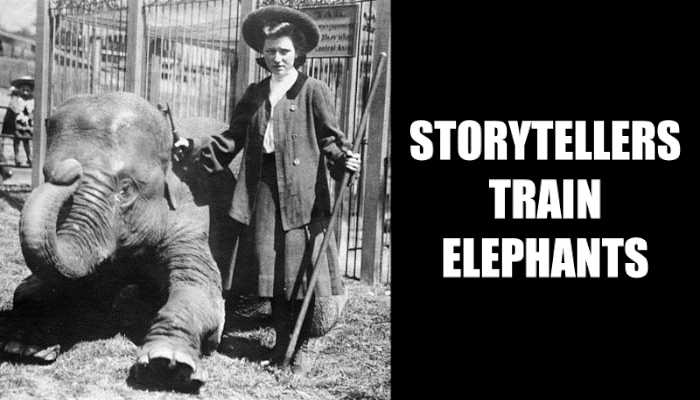
You’re in a sales meeting where everything’s going well. Then, you say something that seems innocuous, but it turns out to be an inflection point in the conversation. Out of nowhere, the client clams up, suddenly “remembers” another meeting, and hastens your exit. As you walk to your car you wonder, “What happened?”
The short answer? You were probably run over by an elephant.
In How to Tell a Story in a Half-Second, we showed how the brain’s right hemisphere, the emotional side of your brain, is an order of magnitude faster than the logical, left hemisphere. When dealing with new information, our emotions command an unfair advantage over our rational thoughts. Therefore, if we want to win the trifecta of the human thought race, we must bet: instinct for the win, emotion to place, and logic to show.
I’ve always thought of this process as thinking fast and slow, but had no way to articulate the raw power of the fast parts. Then I read a great metaphor for the power imbalance between the two: the elephant and the rider.
Social psychologist, Jonathan Haidt, uses an elephant to represent the instinct and emotional side of the human thought. The metaphor works because elephants are both powerful and have inertia. Once an elephant gets going, it can’t be stopped instantaneously. Instead, it must be steered by what Haidt calls the rider, the logical side of human thought who hangs on for dear life while trying to maneuver the elephant toward a specific destination.
While most communicators want to build their messages on pure logic, Haidt suggests that we “…talk to the elephant first. If you ask people to believe something that violates their intuitions, they will devote their efforts to finding an escape hatch—a reason to doubt your argument or conclusion. They will almost always succeed.” 1
Elephants are massive and powerful, yet they can be spooked by a mouse. Once they get going, they’re hard to slow down. Storytellers that ignore them are advised to proceed at their own communications peril.
Haidt believes “…that the Humean model (reason is a servant) fits the facts better than the Platonic model (reason could and should rule) or the Jeffersonian model (head and heart are co-emperors).” 2
In other words, reason is the heart’s servant. And while our ability to overcome both instinct and emotion with logic separates us from the beasts, we are still driven by them. Our job as storytellers is to prevent startled elephants from running over our audiences.
Notes:
1. Jonathan Haidt, The Righteous Mind: Why Good People Are Divided by Politics and Religion (New York: Vintage Books, 2013), 59.
2. Haidt: 79.
Photo Credit: Bain News Service, Publisher. “Hattie” and Hattie Snyder trainer and elephant. , . [No Date Recorded on Caption Card] Photograph. https://www.loc.gov/item/2014680284/.